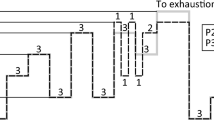Abstract
Bioenergetic models for exercise performance simulations and pacing strategy optimizations currently lag behind empirical knowledge in human bioenergetics. Therefore, the objective of this study was the construction of a four-compartment hydraulic bioenergetic model that incorporates separate oxidative phosphorylation of lipids and carbohydrates and describes the regulation of these energy substrates’ utilization. Furthermore, the aim was also to model efficiency and the impact of muscle fatigue and the force–velocity relationship on the maximal attainable rate of energy expenditure. The model is formulated with five systems of differential equations that regulates the fluid levels in three of the compartments, while the fat compartment energy is kept constant. Regulations had to be imposed on the system of compartments to achieve the desired carbohydrate dependent functionality and efficiency of the model. Equilibrium equations are modeled for the alactic compound composition and a constraint is modeled for the maximal energy expenditure rate, dependent on the intramuscular inorganic phosphate. A separate force–velocity relationship is modeled to constrain power output at low speeds and efficiency is modeled with a linear but off-set relationship between power output and rate of energy expenditure. The relative aerobic contribution to total energy expenditure showed good congruence with empirical results, while time to exhaustion was overestimated due to the constraint on maximal rate of energy expenditure. Therefore, further experimental studies are necessary for complete validation of the model.













Similar content being viewed by others
References
Margaria R (1976) Biomechanics and energetics of muscular exercise. Clarendon Press, Oxford
Morton RH (1985) On a model of human bioenergetics. Eur J Appl Physiol Occup Physiol 54:285–290
Morton RH (1986) On a model of human bioenergetics. II. Maximal power and endurance. Eur J Appl Physiol O 55:413–418
Morton RH (1986) A three component model of human bioenergetics. J Math Biol 24:451–466
Morton RH (1990) Modelling human power and endurance. J Math Biol 28:49–64
Behncke H (1993) A mathematical model for the force and energetics in competitive running. J Math Biol 31:853–878. doi:10.1007/bf00168050
Sundström D, Carlsson P, Tinnsten M (2014) Comparing bioenergetic models for the optimisation of pacing strategy in road cycling. Sports Eng 17:207–215. doi:10.1007/s12283-014-0156-0
Chenevière X, Malatesta D, Peters EM, Borrani F (2009) A mathematical model to describe fat oxidation kinetics during graded exercise. Med Sci Sport Exer 41:1615–1625. doi:10.1249/Mss.0b013e31819e2f91
Coyle EF, Jeukendrup AE, Wagenmakers AJM, Saris WHM (1997) Fatty acid oxidation is directly regulated by carbohydrate metabolism during exercise. Am J Physiol Endocrinol Metab 273:E268–E275
Sahlin K (1986) Metabolic changes limiting muscle performance. In: Saltin B (ed) Biochemistry of exercise VI. International series on sports sciences, vol 16. Human Kinetics, Champaign, IL, pp 323–343
McGilvery RW, Murray TW (1974) Calculated equilibria of phosphocreatine and adenosine phosphates during utilization of high energy phosphate by muscle. J Biol Chem 249:5845–5850
Alberty RA (1969) Standard Gibbs free energy, enthalpy, and entropy changes as a function of pH and pMg for several reactions involving adenosine phosphates. J Biol Chem 244:3290–3302
Kuby SA, Noltmann EA (1962) ATP-creatine transphosphorylase. In: Boyer PD, Lardy H, Myrbäck K (eds) The enzymes, vol 6, 2nd edn. Academic press, New York, pp 515–603
Krause U, Wegener G (1996) Control of adenine nucleotide metabolism and glycolysis in vertebrate skeletal muscle during exercise. Experientia 52:396–403. doi:10.1007/Bf01919306
Heigenhauser GJF, Sutton JR, Jones NL (1983) Effect of glycogen depletion on the ventilatory response to exercise. J Appl Physiol 54:470–474
Hill AV (1938) The heat of shortening and the dynamic constants of muscle. R Soc 126:136–195. doi:10.1098/rspb.1938.0050
Westerblad H, Allen DG, Lannergren J (2002) Muscle fatigue: lactic acid or inorganic phosphate the major cause? News Physiol Sci 17:17–21
Westerblad H, Dahlstedt AJ, Lannergren J (1998) Mechanisms underlying reduced maximum shortening velocity during fatigue of intact, single fibres of mouse muscle. J Physiol 510:269–277. doi:10.1111/j.1469-7793.1998.269bz.x
Gastin PB, Costill DL, Lawson DL, Krzeminski K, McConell GK (1995) Accumulated oxygen deficit during supramaximal all-out and constant intensity exercise. Med Sci Sport Exer 27:255–263
Karatzaferi C, de Haan A, Ferguson R, van Mechelen W, Sargeant A (2001) Phosphocreatine and ATP content in human single muscle fibres before and after maximum dynamic exercise. Pflügers Arch Eur J Physiol 442:467–474. doi:10.1007/s004240100552
Watt MJ, Heigenhauser GJ, Dyck DJ, Spriet LL (2002) Intramuscular triacylglycerol, glycogen and acetyl group metabolism during 4 h of moderate exercise in man. J Physiol 541:969–978
Crowther GJ, Carey MF, Kemper WF, Conley KE (2002) Control of glycolysis in contracting skeletal muscle. I. Turning it on. Am J Physiol Endocrinol Metab 282:E67–E73
Chenevière X, Malatesta D, Gojanovic B, Borrani F (2010) Differences in whole-body fat oxidation kinetics between cycling and running. Eur J Appl Physiol 109:1037–1045. doi:10.1007/s00421-010-1443-5
James A, Green S (2012) A phenomenological model of muscle fatigue and the power-endurance relationship. J Appl Physiol 113:1643–1651. doi:10.1152/japplphysiol.00800.2012
Achten J, Jeukendrup AE (2003) The effect of pre-exercise carbohydrate feedings on the intensity that elicits maximal fat oxidation. J Sport Sci 21:1017–1024. doi:10.1080/02640410310001641403
Author information
Authors and Affiliations
Corresponding author
Rights and permissions
About this article
Cite this article
Sundström, D. On a bioenergetic four-compartment model for human exercise. Sports Eng 19, 251–263 (2016). https://doi.org/10.1007/s12283-016-0205-y
Published:
Issue Date:
DOI: https://doi.org/10.1007/s12283-016-0205-y




